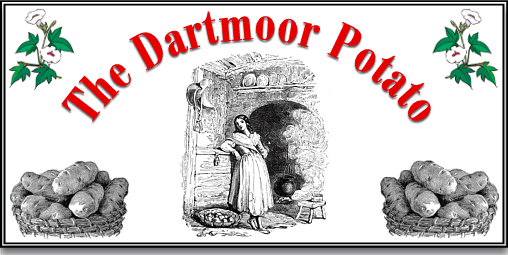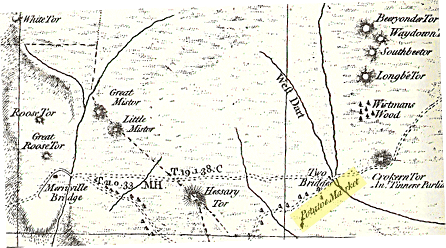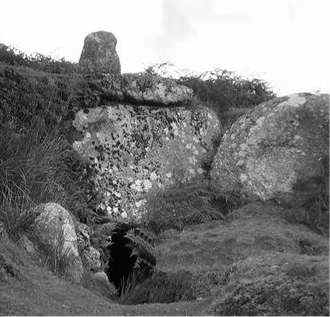
Nobody is sure when and how the potato arrived in this country, some say it was Sir Francis Drake, some say it was Walter Raleigh, others say it was Tom Hawkins and some say it was none of them. The earliest record of the potato is in 1597 when a herbalist called Gerald was growing them. Either way for centuries the old ‘teddy’ has been grown on Dartmoor.
There are two known place names which refer to the potato on the moor, they are both called ‘The Potato Market’. The first one was at Two Bridges and is marked on Donn’s Map of Devon which is dated 1765:

It was here that potatoes grown in the Chagford and Moretonhampstead areas were brought on pack-horses for sale. Consensus of opinion suggests that the peak years of this market were 1770 – 1775.
The second ‘Potato Market’ was at the Merrivale stone rows. There is no evidence of an actual market but according to Mrs. Bray, during an plague outbreak at Tavistock in 1625 food and supplies were left here for the Tavistock locals to collect. There is also a small enclosure at the deserted Fox tor farm called the ‘potato plot’. In the early years many farm leases forbade the tenants from growing potatoes other than for ‘home use’.
In 1796, William Marshall, in his ‘Rural Economy of the West of England’ wrote the following:
“It is not more than twentyfive years, if so much, since the entire Country, including, I believe, the markets of Plymouth, was supplied with Potatoes from the neighbourhood of Moreton Hampstead, at the opposite end of Dartmore, and at not less than twenty miles distance from the centre of this District, nor less than thirty miles from Plymouth and its dockyard! The film of prejudice, however, being at length seen through, Potatoes were found to grow, and to produce their kind, at the West end, as well as the East end of Dartmore; and, now, the District raises enough to furnish its own consumption, and to supply the markets in its neighbourhood; though the population, probably, has much encreased during the lapse of twenty years.
It is reasonable to suppose that the people of Morton, while they monopolized, and practiced as a mystery, the culture of Potatoes, during the length of time, would not inattentive to the minutiæ of cultivation; and it is equally probable, that the knowledge they acquired travelled Westward with the operation.“
Many of the old Dartmoor farms have what are called ‘potato caves’. These were chambers dug into the growan (soft porous rock originating from decaying granite) and were where the potatoes were stored over winter. Another version of this was the ‘potato clamp’ which was a pit dug in the ground and lined with straw or rushes then filled up with potatoes. This was completely covered with soil and would serve the same purpose as the potato cave. It is also noted that the potato caves occasionally were used to store illicit stills and their produce.

Potato Cave
Some of the potato varieties grown on Dartmoor were Sutton’s Abundance, King Edward, Arran Chief’s and Hambley’s Special. The crop was planted between March and June depending on what type or variety was being used. They were either planted in alternate furrows and then covered with dung or they were planted in ‘slips’ or ‘beds’ with narrow ridges of mold earthed up between them to produce ‘lazy beds’. Vancouver, writing in 1808 lists the typical costs of planting an acre of potatoes:
12 bags of potatoes per acre ………………………£1 5 0
Winter ploughing the land per acre, ………………£0 10 0
100 seams of dung, at 4d a seam, ……………….£2 13 4
Tilling, packing, or carting, ditto …………………..£1 0 2
8 men, at 10d per day (no drink), …………………£0 13 4
4 women, 2 to spread the dung, and 2
to lay the setts, at 8d per day each,………………£0 2 8
Second covering, 4 men as above, ……………….£0 6 8
Third covering, hoeing and drawing weeds ………£0 6 8
Taking up 140 bags at 2d per bag, ……………….£1 3 4
Caving and sorting at 1d per bag, …………………£0 11 8
Rent, …………………………………………………… £1 5 0
Tithe and parochial payments, …………………….£0 7 6
Estimated expense, per acre, ……………………£10 5 4
At the time the potato growers of the Drewsteignton area would expect to harvest about 140 bags of potatoes per acre, the market price of which was around 2s 6d which would give a gross return of about £17, deduct the expenses and in proportion there wasn’t an awful lot left.
On the south-western side of Stannon tor is a building called the ‘Sheepfold’ or the ‘scotch sheepfold’. It was here that John and Thomas built a starch factory. The idea was that the starch would be provided by potatoes grown under Stannon tor. Considering that Stannon tor is located on the open moor at 1,500 ft (457m) it is hardly surprising that the venture failed.

Dartmoor ‘Teddy’ Soup.
Ingredients.
2 x medium sized potatoes, peeled and diced
1 x medium sized leek, washed, peeled and sliced
1 oz (28 gm) butter
1 pint (500 ml) of chicken stock
½ pint full cream milk
½ tsp parsley
½ tsp tarragon
½ tsp chives
salt and pepper to taste
Method
Melt the butter in a large saucepan and put in the prepared vegetables, cover and sweat for 10 minutes ensuring they do not brown. Add the stock, milk and herbs and bring to the boil. Reduce the heat and simmer for 30 minutes or until the potatoes are very soft. Liquidise and re-heat to serving temperature. Garnish with sprig of parsley and a sprinkling of paprika. Serve with crusty bread or cheesy toast.
 Legendary Dartmoor The many aspects past and present of Dartmoor
Legendary Dartmoor The many aspects past and present of Dartmoor
